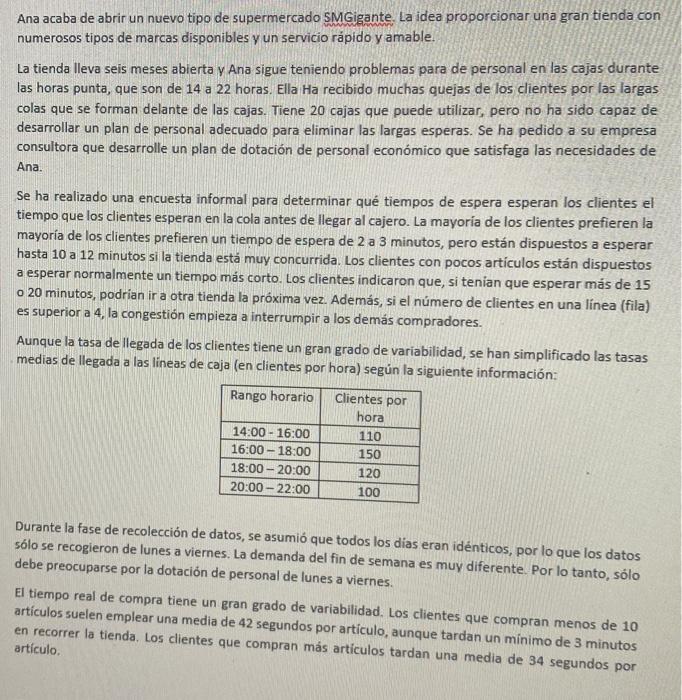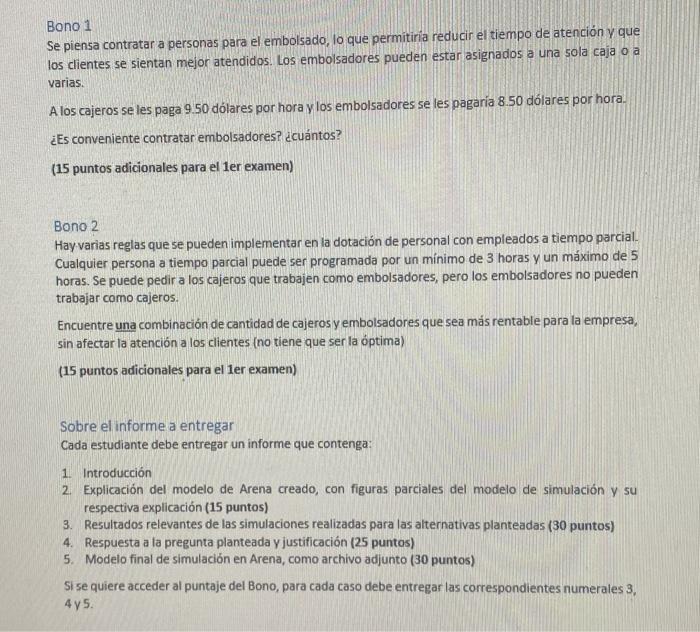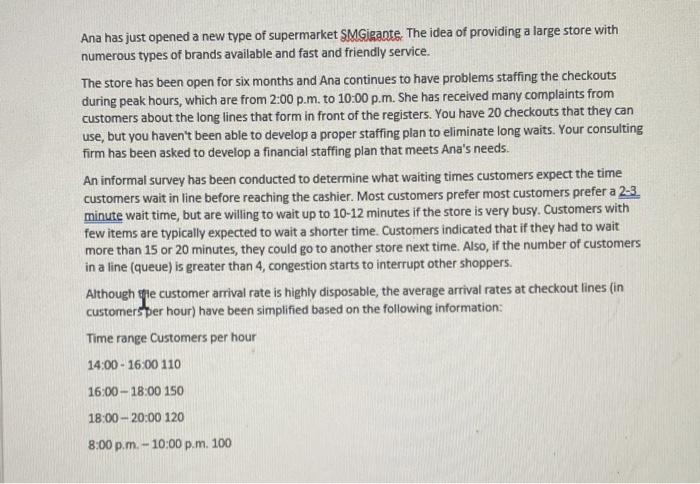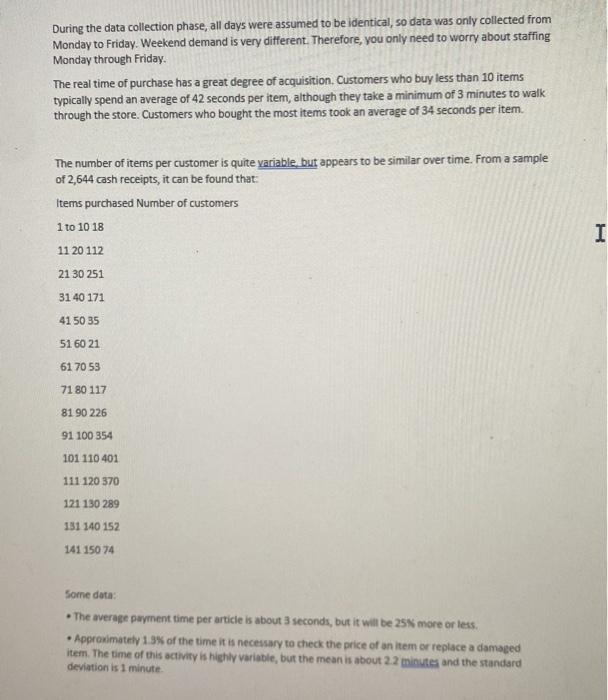If possible i need to see the simulation as well if not its ok
Ana acaba de abrir un nuevo tipo de supermercado SMGigante. La idea proporcionar una gran tienda con numerosos tipos de marcas disponibles y un servicio rpido y amable. La tienda lleva seis meses abierta y Ana sigue teniendo problemas para de personal en las cajas durante las horas punta, que son de 14 a 22 horas. Ella Ha recibido muchas quejas de los clientes por las largas colas que se forman delante de las cajas. Tiene 20 cajas que puede utilizar, pero no ha sido capaz de desarrollar un plan de personal adecuado para eliminar las largas esperas. Se ha pedido a su empresa consultora que desarrolle un plan de dotacin de personal econmico que satisfaga las necesidades de Ana. Se ha realizado una encuesta informal para determinar qu tiempos de espera esperan los clientes el tiempo que los clientes esperan en la cola antes de llegar al cajero. La mayora de los clientes prefieren la mayora de los clientes prefieren un tiempo de espera de 2 a 3 minutos, pero estn dispuestos a esperar hasta 10 a 12 minutos si la tienda est muy concurrida. Los clientes con pocos artculos estn dispuestos a esperar normalmente un tiempo ms corto. Los clientes indicaron que, si tenan que esperar ms de 15 o 20 minutos, podran ir a otra tienda la prxima vez. Adems, si el nmero de clientes en una lnea (fila) es superior a 4, la congestin empieza a interrumpir a los dems compradores. Aunque la tasa de llegada de los clientes tiene un gran grado de variabilidad, se han simplificado las tasas medias de llegada a las lneas de caja (en clientes por hora) segn la siguiente informacin: Rango horario Clientes por hora 14:00-16:00 110 16:00-18:00 150 18:00-20:00 120 20:00-22:00 100 Durante la fase de recoleccin de datos, se asumi que todos los das eran idnticos, por lo que los datos slo se recogieron de lunes a viernes. La demanda del fin de semana es muy diferente. Por lo tanto, slo debe preocuparse por la dotacin de personal de lunes a viernes. El tiempo real de compra tiene un gran grado de variabilidad. Los clientes que compran menos de 10 artculos suelen emplear una media de 42 segundos por artculo, aunque tardan un mnimo de 3 minutos en recorrer la tienda. Los clientes que compran ms artculos tardan una media de 34 segundos por artculo. Bono 1 Se piensa contratar a personas para el embolsado, lo que permitira reducir el tiempo de atencin y que los clientes se sientan mejor atendidos. Los embolsadores pueden estar asignados a una sola caja o a varias. A los cajeros se les paga 9.50 dlares por hora y los embolsadores se les pagara 8.50 dlares por hora. Es conveniente contratar embolsadores? cuntos? (15 puntos adicionales para el 1er examen) Bono 2 Hay varias reglas que se pueden implementar en la dotacin de personal con empleados a tiempo parcial. Cualquier persona a tiempo parcial puede ser programada por un mnimo de 3 horas y un mximo de 5 horas. Se puede pedir a los cajeros que trabajen como embolsadores, pero los embolsadores no pueden trabajar como cajeros. Encuentre una combinacin de cantidad de cajeros y embolsadores que sea ms rentable para la empresa, sin afectar la atencin a los clientes (no tiene que ser la ptima) (15 puntos adicionales para el 1er examen) Sobre el informe a entregar Cada estudiante debe entregar un informe que contenga: 1. Introduccin 2. Explicacin del modelo de Arena creado, con figuras parciales del modelo de simulacin y su respectiva explicacin (15 puntos) 3. Resultados relevantes de las simulaciones realizadas para las alternativas planteadas (30 puntos) 4. Respuesta a la pregunta planteada y justificacin (25 puntos) 5. Modelo final de simulacin en Arena, como archivo adjunto (30 puntos) Si se quiere acceder al puntaje del Bono, para cada caso debe entregar las correspondientes numerales 3, 4 y 5. Ana has just opened a new type of supermarket SMGigante. The idea of providing a large store with numerous types of brands available and fast and friendly service. The store has been open for six months and Ana continues to have problems staffing the checkouts during peak hours, which are from 2:00 p.m. to 10:00 p.m. She has received many complaints from customers about the long lines that form in front of the registers. You have 20 checkouts that they can use, but you haven't been able to develop a proper staffing plan to eliminate long waits. Your consulting firm has been asked to develop a financial staffing plan that meets Ana's needs. An informal survey has been conducted to determine what waiting times customers expect the time customers wait in line before reaching the cashier. Most customers prefer most customers prefer a 2-3 minute wait time, but are willing to wait up to 10-12 minutes if the store is very busy. Customers with few items are typically expected to wait a shorter time. Customers indicated that if they had to wait more than 15 or 20 minutes, they could go to another store next time. Also, if the number of customers in a line (queue) is greater than 4, congestion starts to interrupt other shoppers. Although the customer arrival rate is highly disposable, the average arrival rates at checkout lines (in customers per hour) have been simplified based on the following information: Time range Customers per hour 14:00-16:00 110 16:00-18:00 150 18:00-20:00 120 8:00 p.m. -10:00 p.m. 100 During the data collection phase, all days were assumed to be identical, so data was only collected from Monday to Friday. Weekend demand is very different. Therefore, you only need to worry about staffing Monday through Friday. The real time of purchase has a great degree of acquisition. Customers who buy less than 10 items typically spend an average of 42 seconds per item, although they take a minimum of 3 minutes to walk through the store. Customers who bought the most items took an average of 34 seconds per item. The number of items per customer is quite variable, but appears to be similar over time. From a sample of 2,644 cash receipts, it can be found that: Items purchased Number of customers 1 to 10 18 11 20 112 21 30 251 31 40 171 41 50 35 51 60 21 61 70 53 71 80 117 81 90 226 91 100 354 101 110 401 111 120 370 121 130 289 131 140 152 141 150 74 Some data: The average payment time per article is about 3 seconds, but it will be 25% more or less. Approximately 1.3% of the time it is necessary to check the price of an item or replace a damaged item. The time of this activity is highly variable, but the mean is about 2.2 minutes and the standard deviation is 1 minute. I The form of payment depends on the number of items purchased by the customer. For purchases of 20 or fewer items, 45% of customers pay with cash and 55% pay with a credit card. For purchases of more than 20 items, the values for those categories are 20%, 80%, respectively. All payment transaction times appear to follow a normal distribution, but vary by payment type. Cash payments have a mean of 0.95 minutes, with a standard deviation of 0.17. Credit card payments require a mean of 1.24 minutes, with a standard deviation of 0.21. The bagging time is about 1.25 seconds per item, but can vary up to 20% more or less. The cashier is the one who bags the products. Customers help bag 30% of the time and that cuts bagging time in half. Employees for cash activities are part-time people who work 4-hour shifts. How many people must work at least and in what shifts so that the restrictions proposed in the case are met? Bonus 1 It is planned to hire people for the bagging, which would reduce service time and make customers feel better served. Baggers can be assigned to a single box or multiple boxes. Tellers are paid $9.50 per hour and baggers would be paid $8.50 per hour. Is it convenient to hire baggers? many? (15 additional points for the 1st exam) bonus 2 There are several rules that can be implemented in staffing with part-time employees. Any part-time person can be scheduled for a minimum of 3 hours and a maximum of 5 hours. Cashiers can be required to work as baggers, but baggers cannot work as cashiers. Find a combination of number of cashiers and baggers that is most profitable for the company, without affecting customer service (it does not have to be optimal) (15 additional points for the 1st exam) About the report to be delivered Each student must submit a report containing: 1. Introduction 2. Explanation of the Arena model created, with partial figures of the simulation model and their respective explanation (15 points) 3. Relevant results of the simulations carried out for the proposed alternatives (30 points) Ana acaba de abrir un nuevo tipo de supermercado SMGigante. La idea proporcionar una gran tienda con numerosos tipos de marcas disponibles y un servicio rpido y amable. La tienda lleva seis meses abierta y Ana sigue teniendo problemas para de personal en las cajas durante las horas punta, que son de 14 a 22 horas. Ella Ha recibido muchas quejas de los clientes por las largas colas que se forman delante de las cajas. Tiene 20 cajas que puede utilizar, pero no ha sido capaz de desarrollar un plan de personal adecuado para eliminar las largas esperas. Se ha pedido a su empresa consultora que desarrolle un plan de dotacin de personal econmico que satisfaga las necesidades de Ana. Se ha realizado una encuesta informal para determinar qu tiempos de espera esperan los clientes el tiempo que los clientes esperan en la cola antes de llegar al cajero. La mayora de los clientes prefieren la mayora de los clientes prefieren un tiempo de espera de 2 a 3 minutos, pero estn dispuestos a esperar hasta 10 a 12 minutos si la tienda est muy concurrida. Los clientes con pocos artculos estn dispuestos a esperar normalmente un tiempo ms corto. Los clientes indicaron que, si tenan que esperar ms de 15 o 20 minutos, podran ir a otra tienda la prxima vez. Adems, si el nmero de clientes en una lnea (fila) es superior a 4, la congestin empieza a interrumpir a los dems compradores. Aunque la tasa de llegada de los clientes tiene un gran grado de variabilidad, se han simplificado las tasas medias de llegada a las lneas de caja (en clientes por hora) segn la siguiente informacin: Rango horario Clientes por hora 14:00-16:00 110 16:00-18:00 150 18:00-20:00 120 20:00-22:00 100 Durante la fase de recoleccin de datos, se asumi que todos los das eran idnticos, por lo que los datos slo se recogieron de lunes a viernes. La demanda del fin de semana es muy diferente. Por lo tanto, slo debe preocuparse por la dotacin de personal de lunes a viernes. El tiempo real de compra tiene un gran grado de variabilidad. Los clientes que compran menos de 10 artculos suelen emplear una media de 42 segundos por artculo, aunque tardan un mnimo de 3 minutos en recorrer la tienda. Los clientes que compran ms artculos tardan una media de 34 segundos por artculo. Bono 1 Se piensa contratar a personas para el embolsado, lo que permitira reducir el tiempo de atencin y que los clientes se sientan mejor atendidos. Los embolsadores pueden estar asignados a una sola caja o a varias. A los cajeros se les paga 9.50 dlares por hora y los embolsadores se les pagara 8.50 dlares por hora. Es conveniente contratar embolsadores? cuntos? (15 puntos adicionales para el 1er examen) Bono 2 Hay varias reglas que se pueden implementar en la dotacin de personal con empleados a tiempo parcial. Cualquier persona a tiempo parcial puede ser programada por un mnimo de 3 horas y un mximo de 5 horas. Se puede pedir a los cajeros que trabajen como embolsadores, pero los embolsadores no pueden trabajar como cajeros. Encuentre una combinacin de cantidad de cajeros y embolsadores que sea ms rentable para la empresa, sin afectar la atencin a los clientes (no tiene que ser la ptima) (15 puntos adicionales para el 1er examen) Sobre el informe a entregar Cada estudiante debe entregar un informe que contenga: 1. Introduccin 2. Explicacin del modelo de Arena creado, con figuras parciales del modelo de simulacin y su respectiva explicacin (15 puntos) 3. Resultados relevantes de las simulaciones realizadas para las alternativas planteadas (30 puntos) 4. Respuesta a la pregunta planteada y justificacin (25 puntos) 5. Modelo final de simulacin en Arena, como archivo adjunto (30 puntos) Si se quiere acceder al puntaje del Bono, para cada caso debe entregar las correspondientes numerales 3, 4 y 5. Ana has just opened a new type of supermarket SMGigante. The idea of providing a large store with numerous types of brands available and fast and friendly service. The store has been open for six months and Ana continues to have problems staffing the checkouts during peak hours, which are from 2:00 p.m. to 10:00 p.m. She has received many complaints from customers about the long lines that form in front of the registers. You have 20 checkouts that they can use, but you haven't been able to develop a proper staffing plan to eliminate long waits. Your consulting firm has been asked to develop a financial staffing plan that meets Ana's needs. An informal survey has been conducted to determine what waiting times customers expect the time customers wait in line before reaching the cashier. Most customers prefer most customers prefer a 2-3 minute wait time, but are willing to wait up to 10-12 minutes if the store is very busy. Customers with few items are typically expected to wait a shorter time. Customers indicated that if they had to wait more than 15 or 20 minutes, they could go to another store next time. Also, if the number of customers in a line (queue) is greater than 4, congestion starts to interrupt other shoppers. Although the customer arrival rate is highly disposable, the average arrival rates at checkout lines (in customers per hour) have been simplified based on the following information: Time range Customers per hour 14:00-16:00 110 16:00-18:00 150 18:00-20:00 120 8:00 p.m. -10:00 p.m. 100 During the data collection phase, all days were assumed to be identical, so data was only collected from Monday to Friday. Weekend demand is very different. Therefore, you only need to worry about staffing Monday through Friday. The real time of purchase has a great degree of acquisition. Customers who buy less than 10 items typically spend an average of 42 seconds per item, although they take a minimum of 3 minutes to walk through the store. Customers who bought the most items took an average of 34 seconds per item. The number of items per customer is quite variable, but appears to be similar over time. From a sample of 2,644 cash receipts, it can be found that: Items purchased Number of customers 1 to 10 18 11 20 112 21 30 251 31 40 171 41 50 35 51 60 21 61 70 53 71 80 117 81 90 226 91 100 354 101 110 401 111 120 370 121 130 289 131 140 152 141 150 74 Some data: The average payment time per article is about 3 seconds, but it will be 25% more or less. Approximately 1.3% of the time it is necessary to check the price of an item or replace a damaged item. The time of this activity is highly variable, but the mean is about 2.2 minutes and the standard deviation is 1 minute. I The form of payment depends on the number of items purchased by the customer. For purchases of 20 or fewer items, 45% of customers pay with cash and 55% pay with a credit card. For purchases of more than 20 items, the values for those categories are 20%, 80%, respectively. All payment transaction times appear to follow a normal distribution, but vary by payment type. Cash payments have a mean of 0.95 minutes, with a standard deviation of 0.17. Credit card payments require a mean of 1.24 minutes, with a standard deviation of 0.21. The bagging time is about 1.25 seconds per item, but can vary up to 20% more or less. The cashier is the one who bags the products. Customers help bag 30% of the time and that cuts bagging time in half. Employees for cash activities are part-time people who work 4-hour shifts. How many people must work at least and in what shifts so that the restrictions proposed in the case are met? Bonus 1 It is planned to hire people for the bagging, which would reduce service time and make customers feel better served. Baggers can be assigned to a single box or multiple boxes. Tellers are paid $9.50 per hour and baggers would be paid $8.50 per hour. Is it convenient to hire baggers? many? (15 additional points for the 1st exam) bonus 2 There are several rules that can be implemented in staffing with part-time employees. Any part-time person can be scheduled for a minimum of 3 hours and a maximum of 5 hours. Cashiers can be required to work as baggers, but baggers cannot work as cashiers. Find a combination of number of cashiers and baggers that is most profitable for the company, without affecting customer service (it does not have to be optimal) (15 additional points for the 1st exam) About the report to be delivered Each student must submit a report containing: 1. Introduction 2. Explanation of the Arena model created, with partial figures of the simulation model and their respective explanation (15 points) 3. Relevant results of the simulations carried out for the proposed alternatives (30 points)











